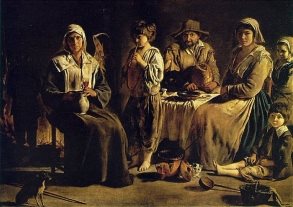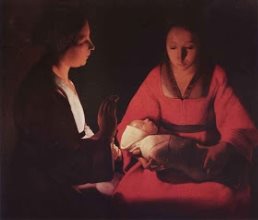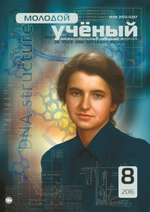Formation of the united state of France and French nation was completed in the beginning of 17th century. Absolute monarchy, promoting overcoming of feudal breaking up and unification of the state, played progressive historical role at that time.
The State centralization assisted economical and political development of the nation. In the second half of the 17th century France became the most mighty State in Western Europe.
Long civil war in the last quarter of 16th century caused to stagnation in the cultural life. By the end of destructive civil wars and religious conflicts under Henry IV (1598–1610) and Maria Medichy wide building began in France — the first symptom of ascent, animation in art activity of the country.
Architecture of France in the first half of 17th century had been still connected with the architecture of 16th century firmly, in which medieval, Gothic forms existed in peculiar synthesis with Renaissance ones.
Luxemburg palace in Paris (1615–1620/21) built by Solomon de Bros (ab. 1562–1626) and Mezone-Laffit palace (1642–1650) built by the project of outstanding architect Fransua Mansara (1598–1666) are created according to the old tradition. In both buildings separate tower like cubic capacities, crowned with peaked roofs, are picked out; in Mezone-Laffit palace vertical articulations emphasize the rush upwards; the building is surrounded with the ditch full of water.
But in the buildings created by S.de Bros and F.Mansara the features appeared, which became typical for a new stylistic stage in the development of French architecture — for the classicism of the composition and logical lucidity of construction (rhythmical articulation of the facade with orders). The building Mezone-Laffit, as it was peculiar to the architecture of former time, broken up into parts complicatedly and skillfully, but all parts, projections, cells are harmonized with each other subtly, as so its volume is perceived as the united, distinctly delimited in the area whole. The inner area of the palace corresponds to the outward volume.
The style of French architecture of this period was formed under the influence of Italian baroque as well. Watch pavilion (started in 1624), forming the central part of western facade of Louver, was built by Jack Lemerse (ab. 1585–1654), who mastered methods of early baroque architecture in Italy. The pavilion is masterly connected with the architecture of Laesco, in particular, with rich plastic study. The fourth flow is the most original one, completed as domelike roof, where four caryatids hold complex baroque pediment. Equilibrium of articulations gives smart building Pavilion calm-harmonious character.
Formation of national style in inventive art of France in the first thirds of 17th century took place in difficult conditions: on the one hand, there existed different opposing branches (f.i. late mannerism) and caravajism), on the other hand, Italian and Flamandian art had a great influence on it (besides, a lot of foreign painters, sculptors and architects worked in the country). A number of great masters had emerged by that time on the arena of art life of France. One of them was the prominent graphic artist and engraver Louie Lenen.
Most of Louie Lenen’s (1593–1648) works are devoted to the life of peasants. Each of the master’s picture is a typical scene of peasant life revealing its characteristic and steady features; one episode represents much, as one personage — the whole estate.
Lenen’s peasants are calm, restrained in their feelings, people of few words — they have a certain aim in life, their inner world is full of dignity and generosity. The painter reveals moral basis, natural, high ethic sense of peasant life. Hence specificity of Lenen’s genre pictures. There is neither event nor story in them; picture is deprived of features of entertainment or rural exotic character.
Significance, the scene obtains, gives everyday motive character of ceremony. In “Visit to the Grandmother’s” (the 1640s, St.Petersburg, Hermitage) it is likened to holiday ceremony; in “The
Peasant Meal” peasants are eating their usual meal — bread and wine — fervently and reverentially as the gift of French land, rewarded their labour.
Originality of Louie Lenen’s painting style defines combination of plainness of personages’ picture and elevated artistic order. Great poeticization is also peculiar to most of his works. In “Halt of the Rider” (the 1640s, London, the Victoria and Albert Museum) the peasants, displayed on the background of wonderfully painted airy landscape, are perceived as the children of nature. Slender girl whose figure is full of strength and grace and the smile fascinates with simple — hearted joy, is usually compared with caryatid.
The lyric and intimate theme of Lenen’s works always accompany the main motive and merge with it. It is connected, first of all, with children’s images which exist almost in each work of the master (the boy playing flute in “The Peasant Family”, 1645–1648, Paris, Louver, and oth.). Lyric element is kept by bright and tender colour, and mild lighting, finally, the landscape playing a great role in Lenen’s compositions: peasants’ life connected with nature continues in it (“Return from the Haymaking”, 1641, Paris, Louver). Life atmosphere is elevated in Lenen’s pictures; there exists rationalistic organizing origin, expressed by language lucidity, by steadiness of compositional construction. It defined their special inner order, far from the poetics of Dutch genre painting.

Lenen. The Peasant Family. 1645- 1648. Paris, Louver.
Louie Lenen was the greatest representative of the direction called “painting of the real world”. Perhaps, the art of another remarkable master — George de Lautur (1593–1652), worked in Lunevil, the town of Lotaryngia, is connected with it.
Great and original talent of the master had been already seen in his early works painted obviously in the middle of the 20s — the very beginning of the 30s: in “The Card-Sharper” (Paris, Louver) and “The Fortune-Teller” (New York, the Metropolitan Museum) — the best pictures of those years — Lautur ennobled subject, deprived base situation of any vulgarity. The scene of “life and disposition” is elevated by monumentality of compositional order, brightness, concentration of emotional reactions, richness of painting fantasy, festive splendour of colour.
Originality of interpretation makes “The Card-Sharper” and “The Fortune -Teller” particular among many other pictures of 17th century in caravajistic painting.
Picture of confessing Magdalene (“Magdalene with the Lamp”, the 40s, Paris, Louver) is unusual according to iconography. In her face, deprived of conventional beauty, in compact silhouette of the figure, given in stature with large scale, combination of severe simplicity and womanly tenderness strikes you.
Ascetic severity of the figure emphasizes spiritual significance of Magdalene: nude feet touching cold floor of the cell, coarse material of the skirt; there is no attractiveness of the body and sensual shade in her nudity -Magdalene’s shoulders and bosom are open for castigation.
In the picture “Christ and Joseph-Carpenter” (the 40s, Paris, Louver) reality of Joseph’s figure is emphasized by the contrast with little and delicate Christ in which all characteristic, individual as if deadened, transformed. However, in hugeness and might of Joseph’s figure, like the arch enveloping all area of the picture and Christ’s figure, in his exaggerated effort, in the dome of his forehead, cut with wrinkles of tense thought, the man, allotted by peculiar destiny, is seen. Special sense is revealed also in his work: comparison of beams, drills and Joseph’s legs form contour of the cross.
The image of Christ is also interpreted in two plans — real (helps Joseph by lighting up the lodging, but his look is directed into the distance — he begins to see his destiny clearly) and abstract aspects: the face of Christ is so radiant thanks to the light piercing it, it seems, it is losing materiality.
The light, whose nature is unknown and which as if Christ himself is radiating, gets symbolic meaning — Christ’s image becomes embodiment of spiritual origin.
Magic of pale flame of the candle burning in the darkness and weightlessly light profile of Christ emerging from deep darkness, light spots scattered everywhere and its reflexes create strained, elevated mysterious mood in the picture.
This emotional atmosphere, with its pretentious, occurs one of the most important components of art order of Lauturian painting. There always exists something strange, unusual, charming and alarming, making foresee another, hidden meaning of events in it. In Lautur’s works reality and fantasy, concrete truth authenticity and inspired poeticization merged indissolubly (“Appearance of Angel to St. Joseph”, the 40s).
Real, earthly and marvelous, that is, spiritual, “ideal” are two images of reality for Lautur. In the picture “Christmas” (the 40s or ab. 1650) sacred event is perceived as the genre scene on the face of it. Boundless tenderness and touching alarming joy of the mother, her humble readiness for sacrifice are transferred pathetically. The faces of women are characteristic, their garments are reliable (Lotaryngian costume of that time), the child’s figure is surprisingly truthful.
This work has the second name — “The New-Born” not by accident. But artistic solution — strictness of the composition, completed and adjusted as musical chord or mathematical formula, intense plastic generalization of figures sculpturesque according to laconism and choice of means, completeness of silhouettes, absolute statics, thanks to which the situation engraved by Lautur as if lasts in times unlimitedly, — elevates the scene over everyday sphere and makes see its elevated prototype in it — picture of the mother with the baby Christ and St. Anna.

G. de Lautur. Christmas. 1640–1650. Renn, the Museum
Interpretation of Maria’s image is significant. Underlined geometrical rightness of figure contours, moveless countenance give her appearance grandeur and monumentality. Extreme generalized, stylized form, in which there is nothing casual, is deprived of tendency to changeability — it personifies ideal beginning. Each feature on Maria’s face is brought to such purity and completeness of expression that as if begins to lose its concreteness, individual unique and obtains plastic perfection of general character.
Light in Lautur doesn’t reflect, as in the painting of Rembrandt, emotional state of heroes, but symbolizes it: he doesn’t violate completeness of the faces of Christ and Maria, which are lighted by the flame of candle and at the same time are shining beautifully and mysteriously, as if the light is proceeding from themselves. Combination of light and colour in the picture fastens their semantic connection: in Lautur’s favourite range of red, yellow and brown colours, turning into pink and lilac ones, as if sound sheens of the flame. “Christmas” is both fascinating scene by its vitality and world of great truths and passions. They merge in the picture unusually harmonious, but the real origin is so strong that religious prototype sounds with imperious, but remote echo.
At the end of the 17th century and the beginning of the 18th century there appeared new attitude towards man in the portraiture of France, consequently, new view point to portrait — there appeared attention and interest to human individuality, naturally, to personality which became peculiar for the portrait style of the 18th century.
When art life of the other main centres of European art of that epoch began to “die away”, when the national schools of Spain, Holland were losing their originality French art rose to the paramount position. In the second half of the 17th century France became the leading art State in Europe and it began greatly influence on the development of culture and art of different countries throughout the Continent.
References:
- Kaптерева T. П., Быков B., Искусство Франции XVII вeкa, Mocквa, 1969
- Пpycc И. E., Maлая история искусств. 3aпaдно — eвpoпeйское иcкyccтвoXVII вeкa, VebVerlagderKunstDresden, 1974; “Искусство”, Mocквa, 1974
- The World Book Encyclopedia, V. 1, 7, 9, 15, Chicago London Sydney Toronto, 1994







